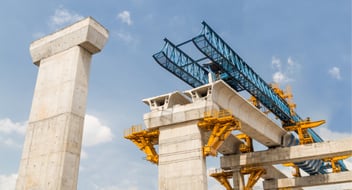
It can be easy to let your mind run away with you when you think of tomorrow's construction projects.
It’s not all a fantasy. 3D printers are creating houses in days. Cities worldwide are using digital twins to improve decision-making and make buildings more sustainable.
Construction technology continues to be developed at lightning speed. Digital collaborative contracts, documenting snags in a few taps on your tablet, even producing concrete based on tech—ConTech is improving every aspect of the asset lifecycle. These innovations improve life for all who work in construction—from the jobsite to those back in the office.
So, what’s caused this surge, and how do we make the most of it?
ConTech to the Rescue
We all know the construction industry is one of the least digitized globally. A fact confirmed by a 2017 McKinsey report—construction coming in just above agriculture and hunting.
However, over the last few years, use and acceptance of tech from construction companies has grown.
The COVID-19 pandemic has undoubtedly spurred on this acceleration. Driven by necessity rather than desire, remote working meant construction workers needed to find alternative solutions to keep their projects moving.
Tech came to the rescue, and projects introduced tech—project management solutions, Virtual Reality (VR), Artificial Intelligence (AI), and BIM—to keep projects moving. This ‘new normal’ also broke down the traditional tech barriers.
With those once adverse to digital solutions realizing its benefits, this growth is set to continue.
As we look to the construction industry's future, research by Deloitte states that “connected construction” will be one of the most significant areas of growth. What does this mean? It involves bringing “assets, people, processes, and job sites onto one platform.”
This idea of bringing the industry onto one platform is also supported by McKinsey, who predicts we are now entering a “platform era.” This involves moving from point solutions to integrated solutions. For example, instead of using one solution for contract management, another for project financials, and a third for document management, one solution can do it all.

Getting Ready for a Connected Construction Industry
What is clear is that the construction industry is changing. And at warp speed.
With construction technology taking off in a big way and more and more players from across the supply chain working together, this can only mean one thing: more data and information to manage.
This creates its own unique challenges:
- Lack of information management
- Data silos
- Missing project information
- Communication failures
To counteract these challenges and get future-ready, projects will need to find a way to manage the vast amount of project data and information generated and prepare for what lies ahead.
 Get Future-Ready with a CDE
Get Future-Ready with a CDE
The best way to deal with an onslaught of data and information? A Common Data Environment (CDE).
A CDE is a central repository that provides a single source of information for the project. It is used to collect, manage, collaborate, and share project information with the project team.
Simply put, a CDE takes all the data and information associated with a project and stores it in one single shared area, making it accessible to the entire team and updating it as the project progresses.
This results in improved accuracy, efficiency, and productivity, resulting in both time and cost savings. In fact, a recent KPMG report suggests a CDE is so vital to productivity that between £5.10 and £6 of direct labor productivity gains could be made for every £1 invested in information management, with between 1.6% to 18% cost savings possible at different asset lifecycle stages.
In North America, this equates to approximately between $7 and over $8 cost savings for every $1 invested in improving information management.
Ultimately, a CDE gives you control over your projects. You can ensure all stakeholders work within the same collaborative environment working from the same shared information.
Other benefits include:
- Facilitates the golden thread of information—quality and up-to-date flow of information throughout the asset lifecycle.
- Makes all project information readily available to all project team members regardless of time or location.
- Creates a central and secure repository for managing your supply chain.
- Improves tasks throughout the asset lifecycle—construction planning, contract management, defects, asset handover, and asset management.
- Creates a centralized knowledge base—allowing knowledge sharing and bringing learnings from one project to the next.
- Ensures compliance with the ISO 19650 international standard of good practice, which names CDEs as the gold standard for managing project information when multiple parties are involved.
When tech takes off, and you’re met with an avalanche of data and information that you need to navigate, a CDE is your best option.
Ready to get prepared for the future of the construction industry? Find out how a CDE can help your projects get future-ready here.
3 minute read
Asite Insights in your inbox.
Sign up for product news and our latest insights published monthly. It's a newsletter so hot, even global warming can't keep up.



